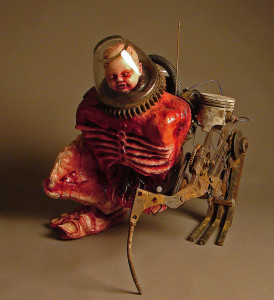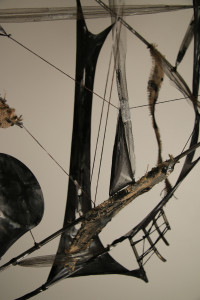 Exquisite corpse or Cadavre exquis is traditionall a drawing technique where a bank of words or images are collected and then assembled to create a finished composition. In this project we will explore this surrealist idea in an assemblage of components to create as “Exquisite corpse” sculptural artifact.
Exquisite corpse or Cadavre exquis is traditionall a drawing technique where a bank of words or images are collected and then assembled to create a finished composition. In this project we will explore this surrealist idea in an assemblage of components to create as “Exquisite corpse” sculptural artifact.
Mission: (Project Description)
In this project the student is asked to create five artifacts from the inventory of objects created from previous mold making assignments. Students are allowed to to melt, cut, deconstruct and transform existing objects and reassemble them into unique sculptural forms/figures. The final form may be prepared as if to be cast in metal using teethe gating method for traditional investment lost wax method. Other materials may be added. Attentions should be given on how additional materials are fastened to the wax objects. Note wether objects will remain as original material or be cast pin metal.
Sketchbook Assignment:
Sketches of your ideas should be rendered before and during sculpting. A minimum of five pages should be dedicated to this sketching component. Draw as you create. Draw what you create. Take notes. Printed images of inspirational sculptures or objects should be placed in your sketch book as well. Your sketch book will be graded along with your project.
Scale:
A 9 to 10 inch object should be the goal of the wax component of this assignment. Five compositions that explore this process is expected. Students are encouraged to develop more than five composition. Focus on strategies and structures that will hold together. A functional wax welding technique is critical for patterns to hold together. Slush larger forms, wax forms larger than a 2 inch thickness should be cast hollow.
Engineering:
Focus your attention on how things go together. Craft is important to allow this form to be ready for the lost wax casting method. Tactics on connecting parts to one another should be a major factor while choosing and making the object as a whole. Structure and how the form stays together compositionally will be held under strong critique.
Material/Structure:
Wax and other components. Wax welding will be explored for this project. Other materials to hold form together will also be a necessity: wire, mechanical fasteners, adhesives, and innovation… Students are encouraged to add other materials/ components to the form. Yet 60 percent of the form should be constructed of components made from molds produced in this course.
Reliquary Component:
Build a reliquary for your final chosen object. This reliquary can take on many forms but should house your form with absolute intent. The marriage between object and reliquary should make sense and have a good balance to focus the audience towards your work. Again craft is very important. Below is a list of types of reliquary objects and materials acceptable for the project.
• Wood: Sculpted, hollowed out, or fabricated wood structures
• A well designed/crafted crate may be fabricated as well.
• Plaster, plastic or wax castings of the body or other objects.
• Note: Plaster can be sculpted cast and hollowed out to hold an artifact.
• Installations: Consider the idea that a reliquary is much like a shrine
• Metals fabrication/containers
• Glass
• Plastics
• Books: Sculpted, hollowed out, or fabricated structures
• Paper, books, and cardboard:
It is expected that the concept and fabrication of the reliquary and the marriage to the object, be convincing. Challenge yourself to meet the aesthetic and craft related to your object or concept and to the echelon of this course.
Tools and Materials:
• Eye Protection/Safety Glasses
• Sketch Book
• Clay Tools
• Hot knife or soldering tool
• Hobby knife
• Fettling knife
• Trimming Tools (Various sizes)
• Loop, wire and ribbon tools
• Wooden modeling tools
• Needle Tool
• Dust Mask/Particulate Respirator
• Safety Glasses
• Wax smelting pot
• Wax
• Wax tools
• Materials for cast pattern
• Mixe media
• Adhesives, fastening materials
• Wood
• Wood Shop
• Metal
• Rubber or Latex gloves
Create a label for your project with these specifics:
• Name:
• Dimensions: HWD
• Materials:
• Year Complete:
• Course:
Tape your label to your project. Use masking tape so that it will not harm your project.
Objectives:
- Method: Planning, Cutting Safely, Building techniques and strategies
- Material Characteristics:
- Three-Dimensional Pattern Making
- Volume: HWD
- Fabrication techniques: Wax casting fabrication, Object creation
- Structural and Aesthetic qualities
- Finishing Techniques: Heat and chemical surface treatments
- Sensibility to form: Good design, clean aesthetics
- Integrity of the artist to their craft
Evaluation:
- Work ethic: Participation in and out of class
- Scheduling: Students stay on task, project finished by deadline, critique.
- Well Engineered and Functional mold for long term use.
- Craftsmanship and aesthetics: Well crafted mold with well crafted “Clean”castings.
Caution:
This process uses chemicals and materials that might be dangerous for some people. Read the MSDS (Material Safety Data Sheet) for questionable materials. Please use a respirator and rubber or latex gloves while using chemicals. A dust mask may be used rather than a respirator. The respirator will provide better protection.
This project will incorporate hot wax and wax welding tools. Be careful for for yourself and when working around others. Safety and a disciplined studio etiquette should be followed during all studio activities.
Research/Inspiration:
U-Ram Cho
Kris Kuksi
Christian Marclay
Tim Hawkinson
Andrew Werby
Louise Bourgeois PBS
Jessica Joslin
Kathie Olivas and Brandt Peters
Elizabeth King
Ron English
Steve Dilworth
Sophie Kahn
Becky McDonah
Christopher Conte
Ashley Wood







